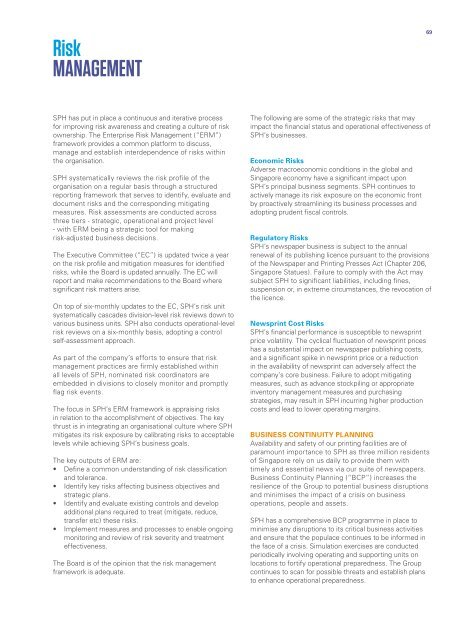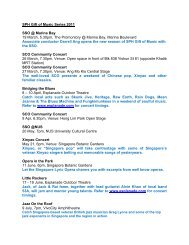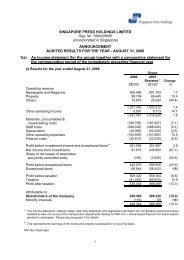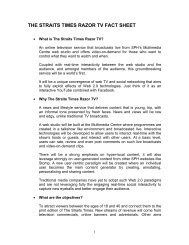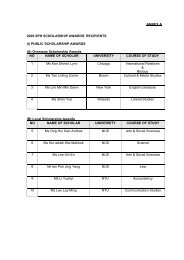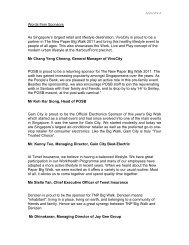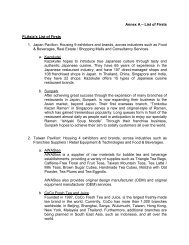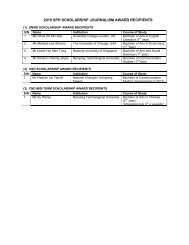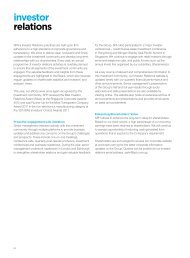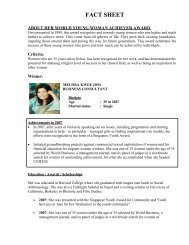Singapore Press Holdings annual report 2011 Singapore Press ...
Singapore Press Holdings annual report 2011 Singapore Press ...
Singapore Press Holdings annual report 2011 Singapore Press ...
You also want an ePaper? Increase the reach of your titles
YUMPU automatically turns print PDFs into web optimized ePapers that Google loves.
Risk<br />
MANAGEMENT<br />
69<br />
SPH has put in place a continuous and iterative process<br />
for improving risk awareness and creating a culture of risk<br />
ownership. The Enterprise Risk Management (“ERM”)<br />
framework provides a common platform to discuss,<br />
manage and establish interdependence of risks within<br />
the organisation.<br />
SPH systematically reviews the risk profile of the<br />
organisation on a regular basis through a structured<br />
<strong>report</strong>ing framework that serves to identify, evaluate and<br />
document risks and the corresponding mitigating<br />
measures. Risk assessments are conducted across<br />
three tiers - strategic, operational and project level<br />
- with ERM being a strategic tool for making<br />
risk-adjusted business decisions.<br />
The Executive Committee (“EC”) is updated twice a year<br />
on the risk profile and mitigation measures for identified<br />
risks, while the Board is updated <strong>annual</strong>ly. The EC will<br />
<strong>report</strong> and make recommendations to the Board where<br />
significant risk matters arise.<br />
On top of six-monthly updates to the EC, SPH’s risk unit<br />
systematically cascades division-level risk reviews down to<br />
various business units. SPH also conducts operational-level<br />
risk reviews on a six-monthly basis, adopting a control<br />
self-assessment approach.<br />
As part of the company’s efforts to ensure that risk<br />
management practices are firmly established within<br />
all levels of SPH, nominated risk coordinators are<br />
embedded in divisions to closely monitor and promptly<br />
flag risk events.<br />
The focus in SPH’s ERM framework is appraising risks<br />
in relation to the accomplishment of objectives. The key<br />
thrust is in integrating an organisational culture where SPH<br />
mitigates its risk exposure by calibrating risks to acceptable<br />
levels while achieving SPH’s business goals.<br />
The key outputs of ERM are:<br />
• Define a common understanding of risk classification<br />
and tolerance.<br />
• Identify key risks affecting business objectives and<br />
strategic plans.<br />
• Identify and evaluate existing controls and develop<br />
additional plans required to treat (mitigate, reduce,<br />
transfer etc) these risks.<br />
• Implement measures and processes to enable ongoing<br />
monitoring and review of risk severity and treatment<br />
effectiveness.<br />
The Board is of the opinion that the risk management<br />
framework is adequate.<br />
The following are some of the strategic risks that may<br />
impact the financial status and operational effectiveness of<br />
SPH’s businesses.<br />
Economic Risks<br />
Adverse macroeconomic conditions in the global and<br />
<strong>Singapore</strong> economy have a significant impact upon<br />
SPH’s principal business segments. SPH continues to<br />
actively manage its risk exposure on the economic front<br />
by proactively streamlining its business processes and<br />
adopting prudent fiscal controls.<br />
Regulatory Risks<br />
SPH’s newspaper business is subject to the <strong>annual</strong><br />
renewal of its publishing licence pursuant to the provisions<br />
of the Newspaper and Printing <strong>Press</strong>es Act (Chapter 206,<br />
<strong>Singapore</strong> Statues). Failure to comply with the Act may<br />
subject SPH to significant liabilities, including fines,<br />
suspension or, in extreme circumstances, the revocation of<br />
the licence.<br />
Newsprint Cost Risks<br />
SPH’s financial performance is susceptible to newsprint<br />
price volatility. The cyclical fluctuation of newsprint prices<br />
has a substantial impact on newspaper publishing costs,<br />
and a significant spike in newsprint price or a reduction<br />
in the availability of newsprint can adversely affect the<br />
company’s core business. Failure to adopt mitigating<br />
measures, such as advance stockpiling or appropriate<br />
inventory management measures and purchasing<br />
strategies, may result in SPH incurring higher production<br />
costs and lead to lower operating margins.<br />
BUSINESS CONTINUITY PLANNING<br />
Availability and safety of our printing facilities are of<br />
paramount importance to SPH as three million residents<br />
of <strong>Singapore</strong> rely on us daily to provide them with<br />
timely and essential news via our suite of newspapers.<br />
Business Continuity Planning (“BCP”) increases the<br />
resilience of the Group to potential business disruptions<br />
and minimises the impact of a crisis on business<br />
operations, people and assets.<br />
SPH has a comprehensive BCP programme in place to<br />
minimise any disruptions to its critical business activities<br />
and ensure that the populace continues to be informed in<br />
the face of a crisis. Simulation exercises are conducted<br />
periodically involving operating and supporting units on<br />
locations to fortify operational preparedness. The Group<br />
continues to scan for possible threats and establish plans<br />
to enhance operational preparedness.


